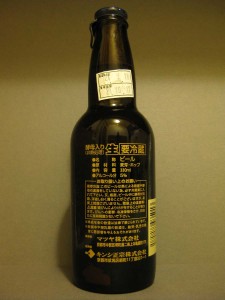
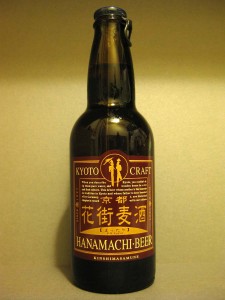 This altbier from Kyoto’s Machiya Brewery has the eponymous qualities that distinguish alts – a bitter, ale-like flavor and matching color. When poured, there is a finger-thick head, which quickly dissipates. Although the head is not persistent, the carbonation is actually reasonably high for a Japanese craft beer: From beginning to end, the bubbling can be felt on the tongue and lips, and each tip of the glass excites new outgassing from solution. The initial flavor is bitter with no flowery or sweet hop note. The bitterness moderates in the middle, allowing a light flowery aromatic to bloom before the bitter fully fades to reveal a maltiness that subsides into a clean, even finish. The color is a light reddish brown, somewhere between a pale ale and a red ale. Compared to the Onuma Alt reviewed here earlier, this one has more carbonation and a stronger bitter.
This altbier from Kyoto’s Machiya Brewery has the eponymous qualities that distinguish alts – a bitter, ale-like flavor and matching color. When poured, there is a finger-thick head, which quickly dissipates. Although the head is not persistent, the carbonation is actually reasonably high for a Japanese craft beer: From beginning to end, the bubbling can be felt on the tongue and lips, and each tip of the glass excites new outgassing from solution. The initial flavor is bitter with no flowery or sweet hop note. The bitterness moderates in the middle, allowing a light flowery aromatic to bloom before the bitter fully fades to reveal a maltiness that subsides into a clean, even finish. The color is a light reddish brown, somewhere between a pale ale and a red ale. Compared to the Onuma Alt reviewed here earlier, this one has more carbonation and a stronger bitter.
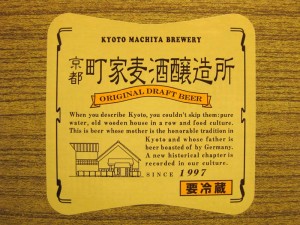 Now the brand and product name are a bit difficult to discern from the label. In the romaji Roman-alphabet text that is easily read by most English speakers, the “Kyoto Craft Hanamachi-Beer,” “Alt-type,” and “Kinshimasamune” are immediately discernable. Without reading the Japanese, one would assume that the brand was “Kyoto Craft”, the variety “Hanamachi”, the type “Alt”, and the manufacturer “Kinshimasamune”. That’s mostly correct. The back label gives us the manufacturer as Machiya Brewery, the beer brewing division of the sake-producing Kinshimasamune Brewery. The appellation given in Japanese above “Alt-type” is “mattari”, meaning “rich” or “full-bodied”. The “Kyoto Craft” is there to tell you that it’s a craft beer from Kyoto, but that’s it: It’s not the brand. The Engrish text on the front label and the variety pack box is a blast! Yo, Momma, who’s your Daddy?
Now the brand and product name are a bit difficult to discern from the label. In the romaji Roman-alphabet text that is easily read by most English speakers, the “Kyoto Craft Hanamachi-Beer,” “Alt-type,” and “Kinshimasamune” are immediately discernable. Without reading the Japanese, one would assume that the brand was “Kyoto Craft”, the variety “Hanamachi”, the type “Alt”, and the manufacturer “Kinshimasamune”. That’s mostly correct. The back label gives us the manufacturer as Machiya Brewery, the beer brewing division of the sake-producing Kinshimasamune Brewery. The appellation given in Japanese above “Alt-type” is “mattari”, meaning “rich” or “full-bodied”. The “Kyoto Craft” is there to tell you that it’s a craft beer from Kyoto, but that’s it: It’s not the brand. The Engrish text on the front label and the variety pack box is a blast! Yo, Momma, who’s your Daddy?
Considering that the concept of craft beers is so similar to the handcrafted, regional nature of sake brewing, it is not surprising that sake brewers have branched into the craft beer business. Additionally, the dominance among craft beers of ales and alts that use top-fermenting yeasts also fits into the realm of experience that sake brewers have, since the koji culture responsible for alcohol production in sake and shochu is also top acting. Bottom-fermenting lager yeasts are usually limited to larger manufacturers who have the outlay for larger facilities with giant tanks with agitators.
Available on the JDM only
Highly recommended
5% ABV
Four out of four drunken monkeys
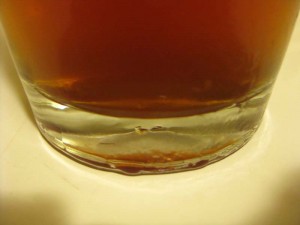
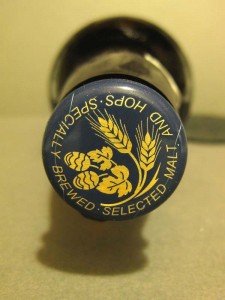
0 Responses to “Beer is Good – Machiya Brewery Hanamachi Beer Jibiiru”